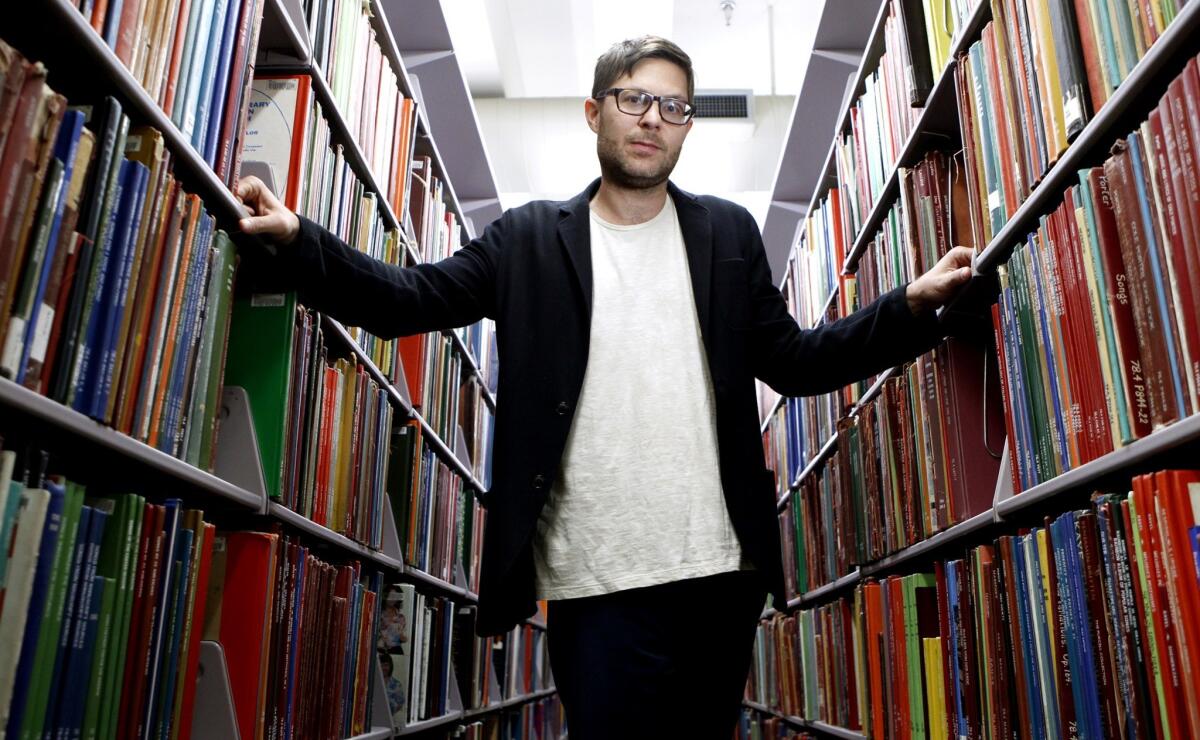These dancing Aztecs, strident and political, prefer movements to the left
Dancing to support gay rights or oppose police brutality is all part of the routine for the hardest-working group in Southern California’s leftist protest circuit.

The Aztecs march in the canyons of the great city.
Their tall feather headdresses jut skyward. They beat drums, stomp and chant. They dance in twirls and high steps, moving forward. One of them presses to his lips a large pink conch, representing the wind god Ehecatl.
Before them at this demonstration between the high-rises of downtown Los Angeles come other tribes of the counterculture: anarchists, socialists, communists, anti-imperialists, Marxists.
They don't dance. With them it's all bullhorns, mohawks, Imperial Stormtrooper outfits, Che Guevara shirts, Guy Fawkes masks and banners that flap in the wind — such as "Smash Imperialist Wars" and "One World Government New World Order." One man breaks off from the group like a herald to peddle a $1 copy of "Revolution."
The people ignore him.
No one ignores the Aztecs. Crowds press close, pulling out iPhones and cameras. The Aztecs have an entourage. They use their arms to keep the crowd at a safe distance, like security behind the line of a red carpet.
At one point during their performance, an intoxicated woman with bleached blond hair stumbles up to the Aztecs' leader, Judith Garcia, and does a precarious, noodle-limbed dance. As the woman's tight blouse begins to roll down, revealing a tattoo proclaiming that she is "Stuart's" — Garcia dances with her, almost cheek to cheek.
Eventually, the woman wraps her arms sloppily around Garcia's neck and gives her a kiss. Then Garcia leads her gently to the sidewalk and hands her a water bottle.
Just another day on the job for the hardest-working members of the leftist protest circuit.

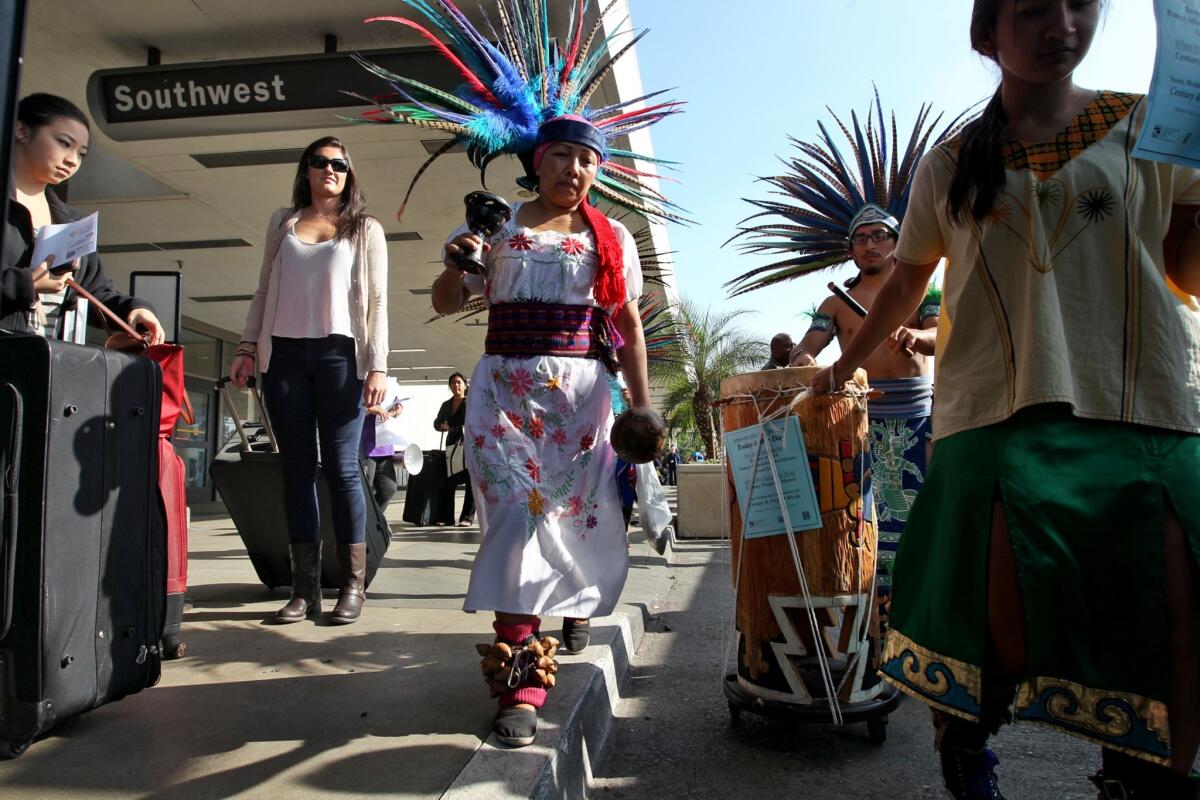
Holiday travelers Megan Kao, and Courtney Poole, from left, watch as Cuauhtemoc Aztec dancers march through LAX to support workers. (Christina House / For The Times) More photos
Aztec dancers have shown up to support gay rights and oppose police brutality. They've been invited to protests by African American groups and Asian ones, including the Korean Immigrant Worker Assn. They've protested Christopher Columbus. Three years ago, they danced and beat drums in Westwood at a pro-Palestinian rally.
"Aztec dancers at a protest for any leftist cause in Southern California are as ubiquitous as 'si se puede' chants and posters of Emiliano Zapata and Che Guevara," says Gustavo Arellano, editor of the OC Weekly and author of the syndicated "Ask a Mexican!" column.
They also frequently dance at antiwar protests, which might seem a bit strange, seeing as the Aztecs weren't exactly known as peace-loving lotus-eaters.
Alexei Hong, 30, an activist for the antiwar, anti-hunger group Food Not Bombs, says the thought sometimes occurs to her when she sees the Aztec dancers.
I think of war and empire, and then it's funny to see them at these anti-imperialist and antiwar protests."— Alexei Hong, Food Not Bombs activist
The myth is that we are a bloodthirsty people, but that's not true."— Judith Garcia, dancing Aztec leader
"I think of war and empire, and then it's funny to see them at these anti-imperialist and antiwar protests," says Hong, who rode her bike at the May Day protest.
The Aztecs, Garcia says, get a bad rap.
"The myth is that we are a bloodthirsty people, but that's not true," she says, picking at her salad at a Denny's the day before the big march. "It's one of the struggles we've had as an indigenous people, the image that has been forced on us to justify all sorts of things that have been done."
Garcia, who also goes by the name Judith Cuauhtemoc, is the 50-something leader of Danza Mexica Cuauhtemoc — Southern California's most prolific political Aztec dance group with about 70 members.
What the Aztecs stand for, she says, is taking a stand for the underdog, the beaten-down: abused workers at the bottom of the wage scale; immigrants fearful of deportation; environmental and indigenous communities.
They've rallied against banks and foreclosures, against the Minutemen who prowl the border. They've been pepper-sprayed, arrested and scattered by rubber bullets and police horses. The Aztecs are not for hire, but they accept the occasional donation.
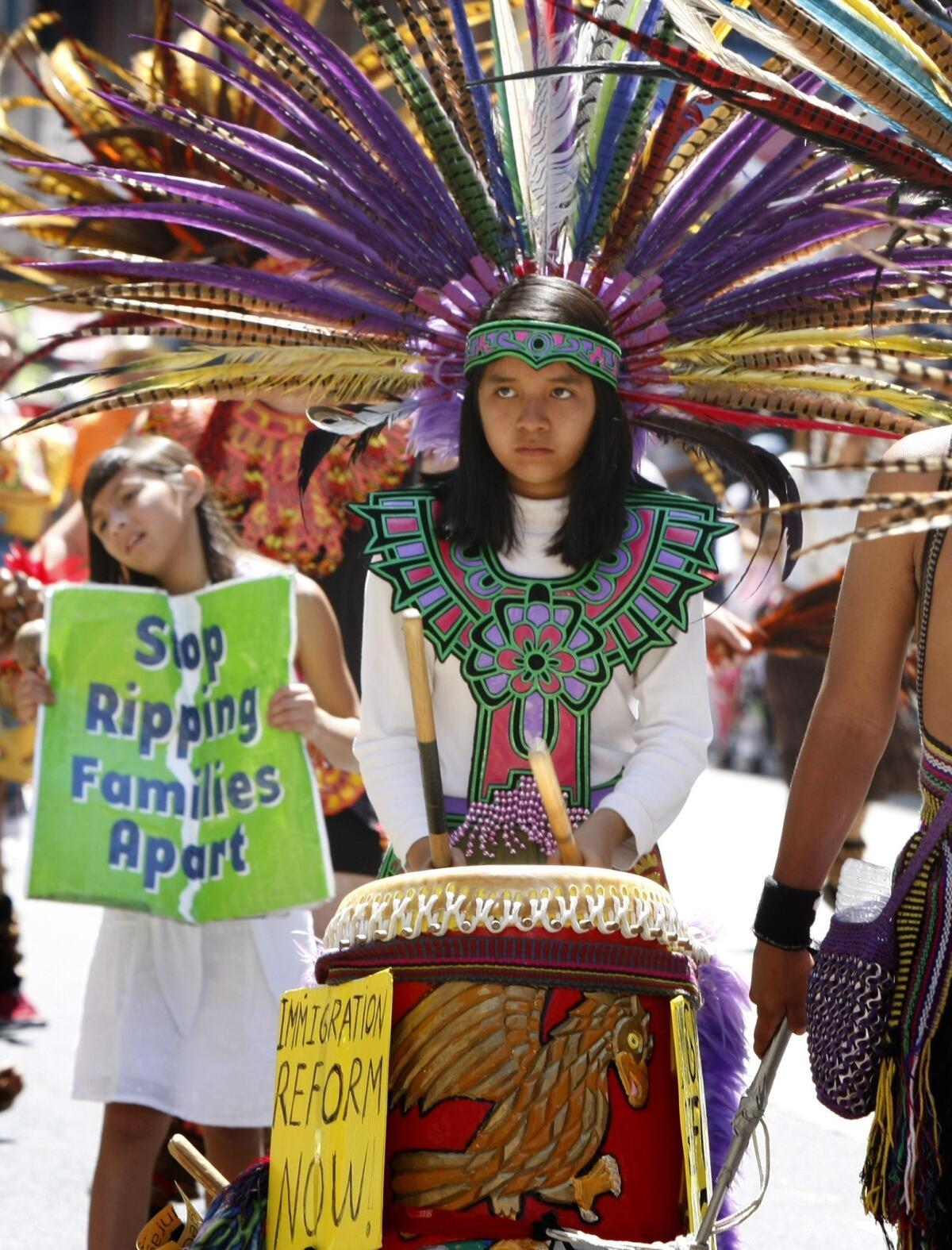
A young costumed member of the Aztec dance group beats a drum during a May Day march downtown. The group is often seen at L.A. street protests. (Don Bartletti / Los Angeles Times) More photos
As another Aztec, Jaime Calderon, 49, puts it: "Any good cause, we'll show up."
Hong, the antiwar activist, is happy they do. "It adds a nice element of energy to boring marches," she says. "I've never found that anywhere else in any other city, where you always see the Aztecs coming down.
"It's a very L.A. thing. It's like at the end of the march, 'There they are.'"

It's not just the large events. For nearly three years, Garcia's group has made a stand for remaking the immigration system almost every Thursday evening on the Alameda Street overpass above the 101 Freeway northeast of downtown.
The day after the May Day protest, Garcia braided her hair and put on an elaborate chest plate on a street just off Alameda. About half a dozen other dancers, including her young son and daughter, showed up. Her headdress, with the feathers of pheasants, sits on a tall drum.
Garcia says she grew up in a family with strong indigenous roots. They lived just outside of Mexico City in an ejido, communal land that was part of a system dating to the Aztecs' rule. Back then people in Mexico, like her grandmother, were discouraged from speaking indigenous languages. Even today, she points out, popular Mexican telenovelas usually feature more European-looking actors while all but ignoring the more indigenous.
It wasn't until Garcia came to L.A. in the early 1980s that she says she really "rediscovered" Aztec dance. The group she joined took part in cultural events but dived into political issues as well.
"No activity that humans do is apolitical," Garcia says. "We're political, one way or another. Even denying it, you're taking a political position."
Over the years, Aztec dancers became a sort of shorthand not only for the indigenous community, but also for spirituality among leftist groups that eschewed organized religion.
"To radicalized Chicanos, the Aztecs are the great lost cause of Mexico," Arellano says. "The Spaniards beat them, they built Mexico City over Tenochtitlan and there's the whole myth of Aztlan, which of course most Mexican Americans don't believe in."
Of course, he adds, they "were the top of the food chain" before the Spanish came — an "empire" that did unto others what empires are wont to do.
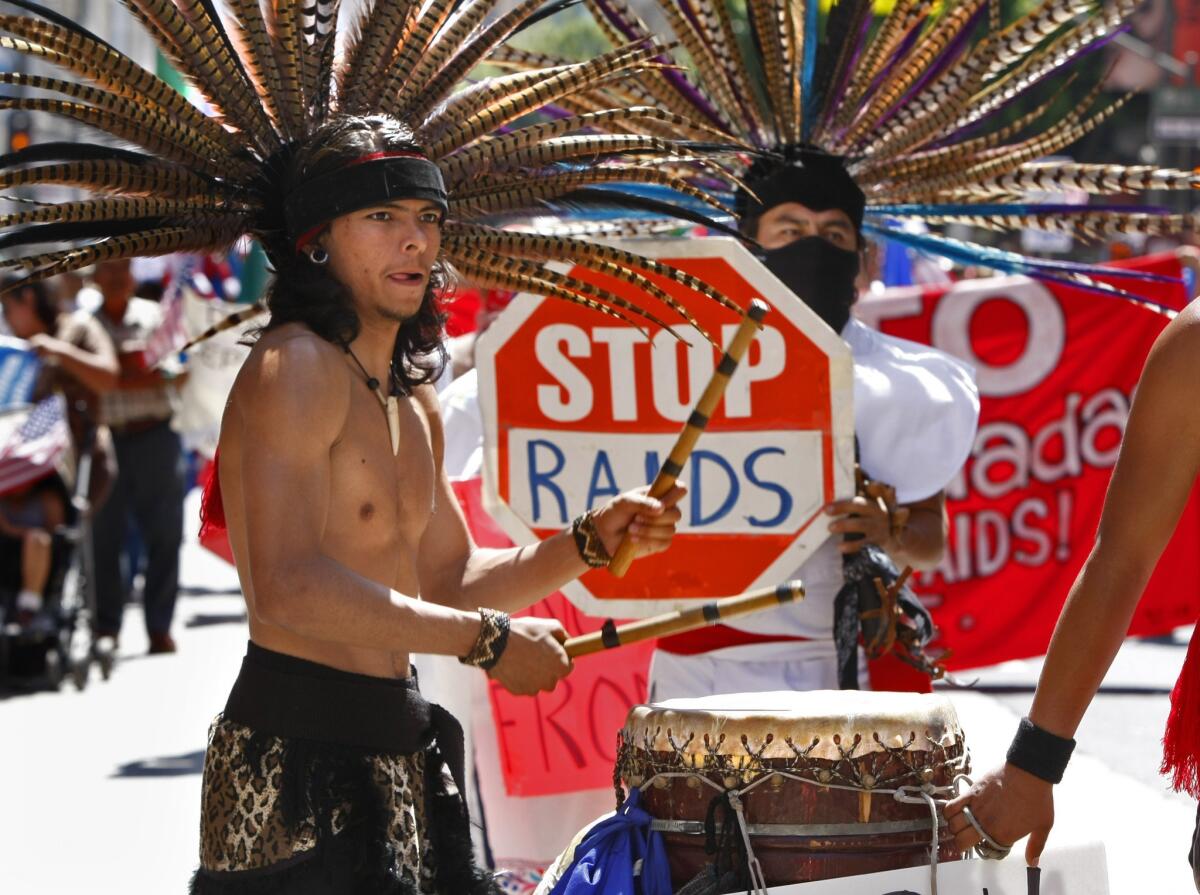
Aztec dancers on May Day. "Aztec dancers at a protest for any leftist cause in Southern California are as ubiquitous as 'si se puede' chants," says Gustavo Arellano, editor of the OC Weekly and author of the syndicated "Ask a Mexican!" column. (Don Bartletti / Los Angeles Times) More photos
Still, there's something universal — whether it's the Irish or the Scots recalling English domination — about trying to lionize one's ancestors, Arellano says, "and especially the warrior class."
"I think Aztec dancers are pretty cool. The pomp and circumstance is definitely awesome."

The group plants itself on Alameda Street close to Union Station and a federal building. They're there to protest for immigration reform, as they have since Arizona passed the nation's strictest law against illegal immigration in 2010.
Even though the prospect of immigration reform looks more realistic now than it has in many years, Garcia says the group won't stop protesting until it's "in writing."
"I knew it was going to be a long battle. I said, 'We're going to be here for a loooong time,'" she recalls.
Juanita Calderon, 73, holds a cup with incense made with the resin of a copal tree. Calderon says she uses the incense to make an offering to the four winds before every event. She wears a chest plate with the ornate image of the feathered serpent deity Quetzalcoatl.
While the massive protests often have a good number of like-minded people, smaller ones like this one sometimes get mixed reactions, and often from Latinos.
"I think out of every 20 cars that pass by, one is rude. Maybe two," Calderon says. "Some of them give you the thumbs up, but others give you the thumbs down. I just tell them, that's where you're going. I don't tell them in words, I just send them my thoughts."
The dancers stand before her, arms outstretched, as she spreads the smoke around them.
The dancing starts, and every few minutes Calderon's son Jaime blows the conch. A banner against the fence above the 101 Freeway reads: "Immigration Reform Now." They dance in line on the sidewalk, with one dancer standing at a corner, holding signs with messages calling for the end of raids and deportations of the undocumented.
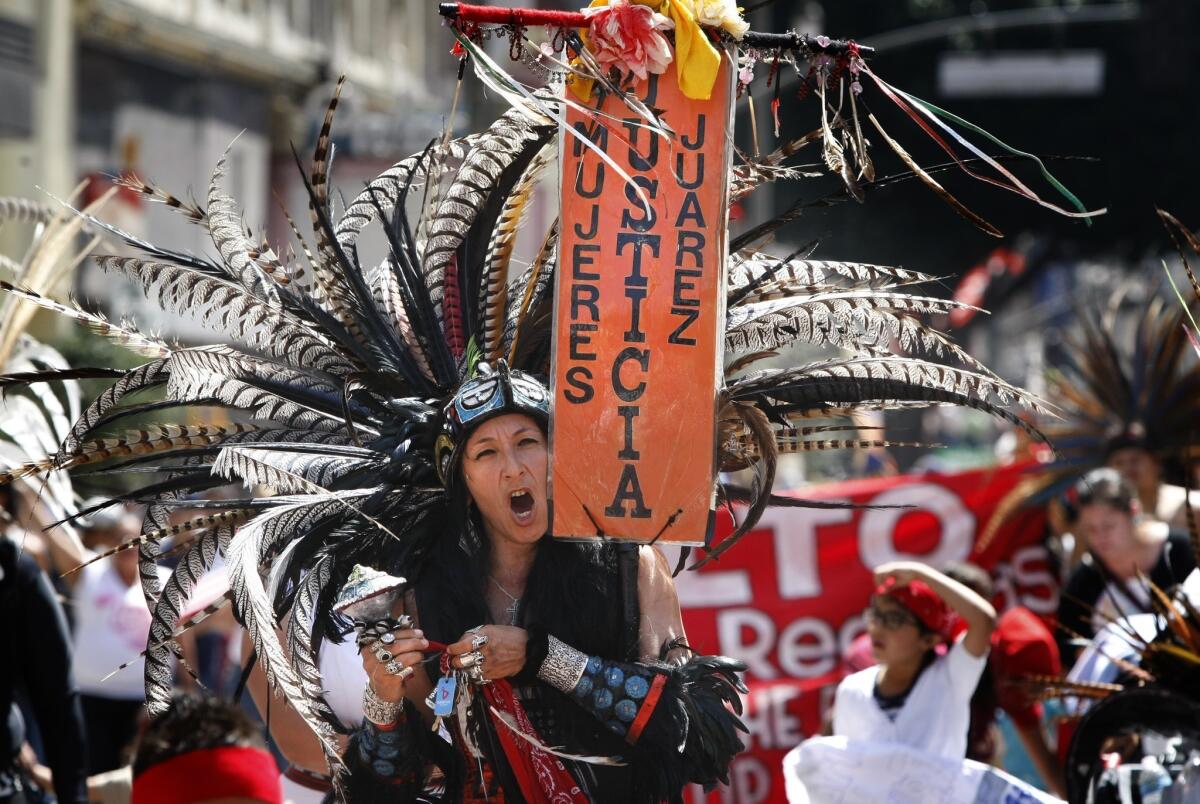
Aztec dancers have shown up to support gay rights and oppose police brutality. They've been invited to protests by African American groups and Asian ones, including the Korean Immigrant Worker Assn. They've protested Christopher Columbus. (Don Bartletti / Los Angeles Times) More photos
Men in suits walk by. An elderly Asian man smiles from the passenger seat of a car. In another car, a young man, his face scrawled with gang tattoos, looks impassively at the dancers as a young woman rolls her eyes and takes a swig from a bottle of Tecate beer. Some drivers lean into their horns in support.
"What do we want?" one of the dancers yells. "A just immigration reform!" the rest answer.
The conch blows in unison with the whine of an ambulance. Faces stare from the windows of a bus; a young black man holding a cigarette pumps his fist and screams, "Yeah!" A young woman holding an iced coffee with one hand and the steering wheel with the other shakes her head.
"This is our land," Garcia cries. "This is our struggle," the other dancers reply. "Long live the organized workers," she says. Cars slow and some passengers click photographs.
About an hour after it began, the weekly demonstration is over. They pack their belongings and look eastward toward their cars. It's about 6 p.m.
The Aztecs exit. Stage left.
Start your day right
Sign up for Essential California for news, features and recommendations from the L.A. Times and beyond in your inbox six days a week.
You may occasionally receive promotional content from the Los Angeles Times.
